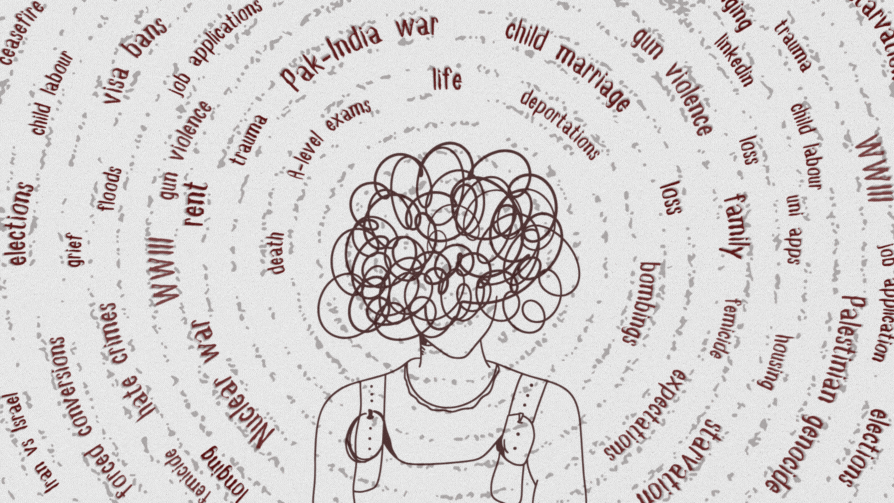Can performance art in Pakistan bridge the gap between artist and audience?
Many years ago in Lahore, in an unassuming backwater spread of the city a little drive off the airport road, I walked in on a performance. It was fall of 2009, and the Grey Noise gallery had just begun the preview for its show 'Patrons of Oh My God! I can afford Art!'
Walking through the main entrance and weaving my way through the works of several artists, I found myself in the last room in front of a man seated at a table. He wore a modest white shalwar kameez and looked quite unaffected by the people milling around him. He was making his way through a pile of papers on his right, ripped out of a set of books on his left, neatly folding each leaf to make a small paper bag, with the sides pasted together with a liberal stroke of glue spread with his index finger.
The man would use the sides of his palms to press out any air bubbles in the glued sides, thump on it for affect and then let the fresh piece dry atop a slowly growing pile of assembled paper bags.
After making several of these, he would pause to pick one that was dry, press the sides to make the flat packing buckle and then blow inside it for it to open up. A few seeds from a plate in front of him were scooped and quickly packed in – aubergine, chilli, honeydew melon and cabbage. At a clockwork pace, each act was made with an orchestrated deliberation.
The idea of bringing in the craftsman as the central piece of the performance addresses the contentious arts and crafts debate that has raged endlessly at the art schools and institutions of Pakistan.
This performance was part of David Chalmers Alesworth and Adnan Madani’s collaborative project The People's Art and Historical Project (P.A.H.P.) and was titled People's Art Historical Garden Centre. The man in the performance was Mahmood the Bookbinder, and he was slowly but surely tearing his way through Akbar Naqvi’s ‘Image and Identity: Fifty Years of Painting and Sculpture in Pakistan’ (Oxford University Press, 1998), making packets, filling them with seeds, and distributing them to the visitors at the gallery.
In his documentation of this performance, David notes that, people began to ask for paper bags made of specific pages in the books – with text or artwork of their choice.

The obvious significance of the performance itself is hard to miss. The book, which has been championed as an unquestionable, authoritative account of Pakistani art history, is in fact considered by some to be a prejudiced and polarised portrayal; and there have either been omissions of several important individuals, or no attempt to engage in dialogue with a few of the many artists it includes. As heard in the voiceover, David speaks of the content being ‘libellous’ and summaries his introduction in the book as ‘more of a landscape gardener than an artist’.
But it is perhaps more interesting to observe how nuanced the performance in response is. The bookbinder and the workmanship of crafting bags from recycled paper – not unlike those made and used by street shops and hawkers to sell snacks – makes a reference to David’s long engagement with urban craftsmen in many of his own works, as well as the collaborative ones.
As another layer, the idea of bringing in the craftsman as the central piece of the performance addresses the contentious arts and crafts debate that has raged endlessly at the art schools and institutions of Pakistan. The use of live seeds nods towards his identification as a horticulturist in the book, owning an imperative facet of his practice and his person, and from what I understand, refusing to let it become an ignominious label.
David narrates it as an ‘undoing’ of the text, in which the packaged knowledge is taken apart and spread with seedlings, encouraging a newer dissemination of information, and allowing it to flourish.
The documentation video can be seen here.
Fast-forward to a few years later. It is 2012, and the performance is set in the storage room of the Zahoor ul Akhlaq gallery at the National College of Art (NCA), Lahore. The MA (Hons.) Visual Arts thesis display has been set up and the first round of juries has begun.
One of the contenders is Sarah Ahmed Mumtaz, an artist often associated with whimsical illustrations that are frequently loaded with sharp critique of the world around her. Over the years she has ventured into performance – both engaging with a live audience and those recorded for video transmission – which have centred around deeply personal narratives of physicality, sexuality and social stigmas that surround the physical impairment to her legs as a result of Cerebral Palsy.

The NCA performance piece was presented to a closed group and was photographed and filmed, which Sarah was able to share with me afterwards. The small cluttered storeroom was cleared out and furnished with personal items and furniture from Sarah’s own room.
Her drawings, prints, photographs and embroidered textiles served the dual purpose of decorating the room and presenting the portfolio of work made towards this final project. A TV played a static screen and was accompanied by only audio of a video piece she had done earlier where she had approached male friends and acquaintances and spoken openly about her interest in them, all the while recording their acutely uncomfortable responses.
Sarah Ahmed mentions that she took delight in the response of the general public – some of whom who cried; some who just expressed shock; with many others who were mostly scandalized at her short dress, which exposed her sheer stocking-ed legs.
The actual performance piece included her responding to the audio while she sat in front of mirror putting on, and subsequently taking off, garish makeup in an attempt to look beautiful. She proceeded with trying on a number of shoes lying in front of her, discarding each one with increasing frustration. She paused to pick a golden thread and stitch painfully through her sheer stockings, enacting the sowing and mending of broken limbs.
The act of changing the shoes reached a fever pitch where she started flinging shoes out of the way, all the while screaming sub theek ho jaye ga (it will all be ok) – until she reached a golden pair of shoes, upon which she settled. She then got up, switched off the lights, signalling the end of the performance.
When it was re-enacted for public audiences later, much of the performance’s progress depended on audience response, with Sarah’s initial stage fright eventually converting to a voyeuristic component of the show. She mentions that she took delight in the response of the general public – some of whom who cried; some who just expressed shock; with many others who were mostly scandalized at her short dress, which exposed her sheer stocking-ed legs.
Their responses helped her to push her own limitations. While in her first performance Sarah was so overwhelmed that she burst into uncontrollable tears, the subsequent performances became more controlled, but still remained organic, changing a little bit each time.
The performances retold above look at two specific trajectories in contemporary art discourse in Pakistan, and I use them very liberally to help illustrate what I see as the role of author and audienceship. David’s piece found a home in the duration of a gallery preview where the audience entered, exited and interacted with it at their own pace, not affecting the proceedings of the performance. And there was no final climatic conclusion to await and understand what was being intimated. It was a calculated and heavily loaded riposte that took to task a canon of Pakistani art history.
The presence of the audience plays a vital role in the theatrical development of the performance.
The component of institutional critique stemmed from David’s own background as an art educationist and his relationship with the framework of modern and contemporary history pedagogy in Pakistan. The work left behind multiple and complex readings, and caused ripples that still resonate with many who speak about opinionated contextualisation in our texts.
On the other hand, Sarah’s performance was dramatic and theatrical – much in the manner of the happenings of the 60s and 70s in the US when artists began challenging conventional aesthetics of making and presenting art, introducing the audience to participation-based artworks and using the personal and the everyday life as subject matter.
Sarah’s performance relied heavily upon her own inexperience with the medium because in a way she wasn’t confined to the constructed restrictions of how the medium is supposed to operate – a risky route to take for an artist who had little exposure or guidance to such expression before.
Additionally, the presence of the audience played a vital role in the theatrical development of the performance, and catered to the artist’s need to bring the outside into an inner circle of hysteria. Sarah’s other piece ‘Sarah Learns to Walk’ (for the Vasl International Artists' Workshop 2012 for Performance, Moving Image and Sound, a project by Vasl Artists' Collective) was performed in a similar vein.
Sarah Learns to Walk can be seen here.
This essay is meant as a reflective text that aims to pull the reader back in the recent past and re-engage with two seemingly random moments in contemporary art practice in Pakistan. Each is important in the small but significant mark it makes: one in challenging the authoritarian construction of art history; and the other in working through a relatively unchartered realm for both local artists and audiences.
The essay is written in realisation that these are not isolated events, neither are they the first of their kind. The selection, then, has been made purely on the basis of narrative flow and to see the varying products of performance projects, and enjoying how the differences are propelled by the two practitioners’ personal experiences, exposure and line of enquiry.
This article, originally published in Art Now Pakistan, has been reproduced with permission.













